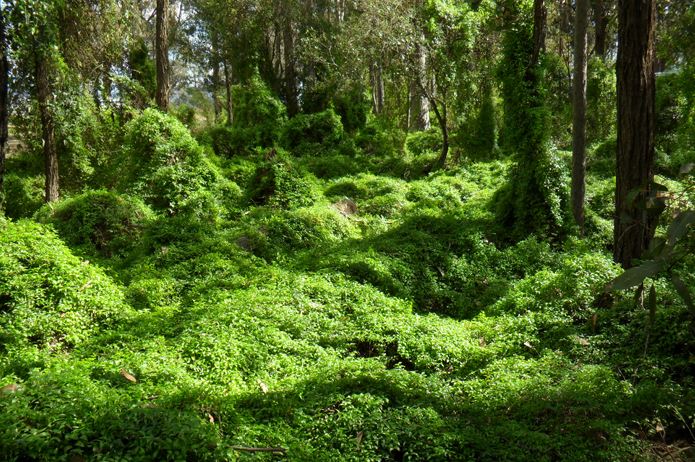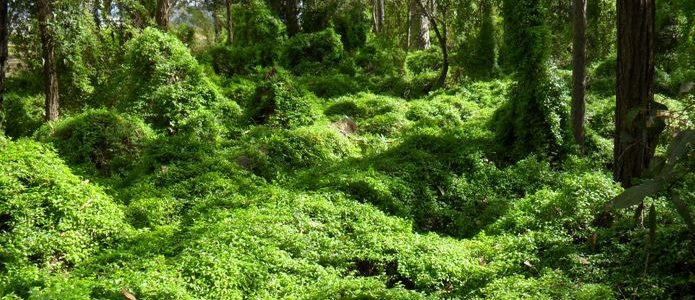After doing some bush regeneration work, my bush regeneration team noticed that a few houses that back up onto bushland had been responsible for dumping their green waste, including grass clippings over the fence. My supervisor reminded me that this is a problem for them and the health of the bushland or reserve because that is how weeds spread here in the first place.
What is a Weed?
Weeds are classified as any plant that has situated itself somewhere it is not wanted. In this blogs context, they are plants that are occur in an environment in which they are not native to.
Weeds are a big problem here in NSW as they compete with native flora for natural resources such as water, light, nutrients and space. They can also harbor diseases and pests.
This impacts Australia’s native wildlife as they depend upon native tree’s and plants for shelter, food and nesting. More concerning is that weeds often grow faster then their native competitors and so they can out-compete them to become dominant in natural areas. The natural pests that would usually control or reduce their growth are lacking as the plants have been introduced somewhere else.
65% of weeds invading reserves or bush land areas have come from urban gardens
Garden Escapees & Other Weeds of Bush land & Reserves
It is hard to control weeds once they have established themselves and end up being very economically and environmentally costly.
There are over 1,350 invasive species that have naturalized themselves here in NSW and 300 of them are having significant environmental impacts to NSW ‘s biodiversity and primary production.
Green Waste Dumping
When you dump your waste into reserves or nearby bushland, you are actually introducing those plant species into that reserve and they can spread, depending on the species, relatively fast.

Bridal creeper, Asparagus Asparagoides is an example of a weed that was introduced as a garden plant but spread significantly into bushland and has now widely established itself in Southern Australia. In fact, it has been labelled as a weed of National Significance in Australia due to its invasiveness, potential of spread and economic and environmental costs.
Bridal creeper is damaging to native plants because it grows as a thick mat of underground tubers over the bushland floor and actually slows down the root growth of other native plants and quite often prevents that species from seed establishment.
Some native plants are being so overthrown by bridal creeper that they are now threatened to near extinction, one example is the Rice Flower, Pimelea spicata.
Weedy Garden Plants
Some plant species are called ‘weedy garden plants’ because they can spread into bushland even if they remain in your garden bed. They do this by their ability to spread by vegetative means, such as through their bulbs, root parts, corms, tubers or stem fragments. They can also be transferred outside their garden bed by the wind, water and from animals such as birds that eat and defecate the fruit to another area.
What Can We Do?

We definitely have the capacity to help reduce the spread of weeds into our beautiful bushland and nature reserves by making small but meaningful actions such as:
- Plant Natives – This helps create a corridor for native wildlife in urban areas, providing them with a path for shelter, food and nesting. It also replaces purchasing exotic plants which have the potential to spread to nearby bushland.
- Dispose your green waste responsibly – Avoid dumping your green waste into reserves or bushland and instead use your green waste bin. Another alternative is to use a compost bin to turn your green waste into nutrient rich soil.
- Regularly prune your garden plants after flowering to prevent seed set and dispersal
- Cover Green Waste if you are transporting your garden clippings in a trailer – This prevents seeds and weeds blowing off and invading roadside and bushland areas
- Use your General Waste bin to put your plant tubers, bulbs and seed heads into rather then your green waste bin to avoid seed dispersal
Sources:
2012 ‘Garden Escapes & Other Weeds in Bushland and Reserves’, Sydney Weeds Committees, Available at: https://www.hawkesbury.nsw.gov.au/__data/assets/pdf_file/0007/62557/SWC_GardenBooklet_WEB_VERSION1.pdf
‘Weed Management Guide – Bridal Creeper (Asparagus Asparagoides)’, Weeds of National Significance – National Heritage Trust, Available at: https://www.environment.gov.au/biodiversity/invasive/weeds/publications/guidelines/wons/pubs/a-asparagoides.pdf

